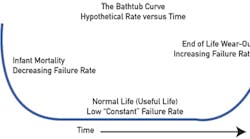About the Author
Dan Hebert, PE, is Control's senior technical editor.Paul Avery, senior product training engineer with the Drives & Motion Division of Yaskawa America (www.yaskawa.com), explains commonly used lifecycle cost terminology:
- Lifecycle Cost (LCC) is the cost of using an item in its intended application over the entire time period of expected use. LCC typically takes into account lost production and corrective maintenance cost.
- Total Cost of Acquisition (TCA) is all the costs associated with buying goods, services or assets.
- Total Cost of Ownership (TCO) is LCC + TCA + operating cost + disposal cost.
- Mean Time Between Failure (MTBF) is the expected time between two consecutive failures for a repairable system. It's also the ratio of the cumulative operating time to the number
of repairable failures for that item over the time that the failure rate is stabilized.
MBTF must be determined based on a period of time when the failure rate has stabilized. In practice, this means eliminating failures due to the initial infant mortality and final wear-out portions of the bathtub failure rate curve (Figure 2,). This stabilized failure rate is sometimes referred to as an exponentially distributed failure rate. MTBF enters the picture as a factor in calculating LCC because it can be inferred that the greater the MTBF, the lower the LCC.
The "Bathtub curve" of a typical lifecycle
Figure 2. Bathtub curve failure rates versus time.




